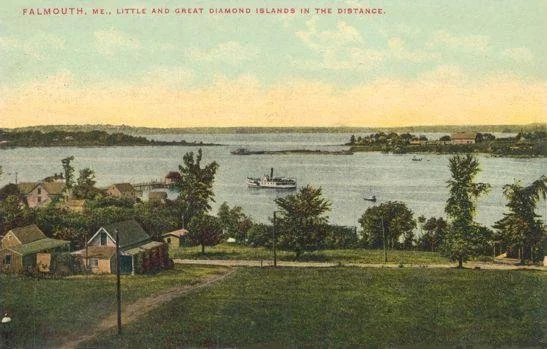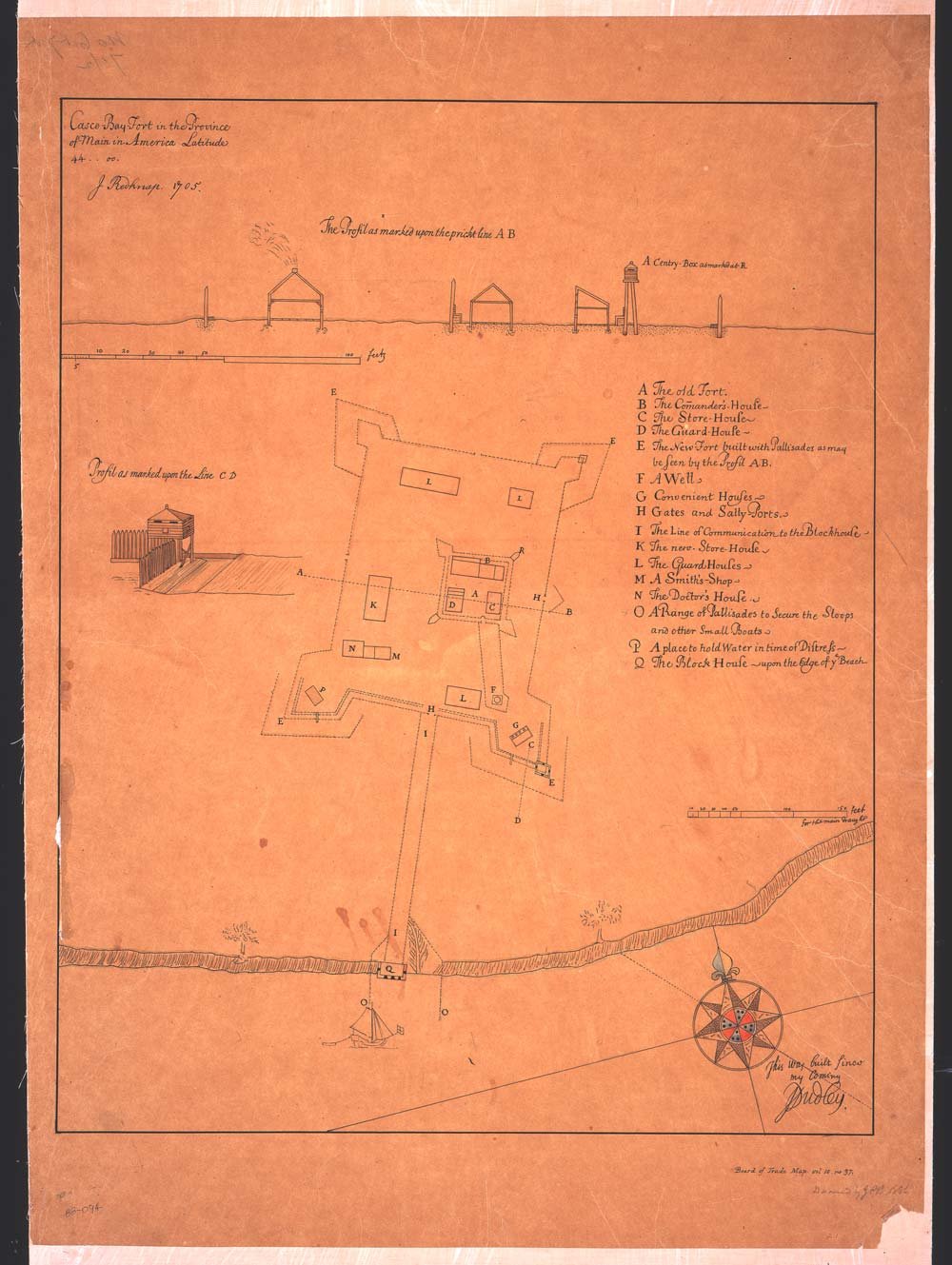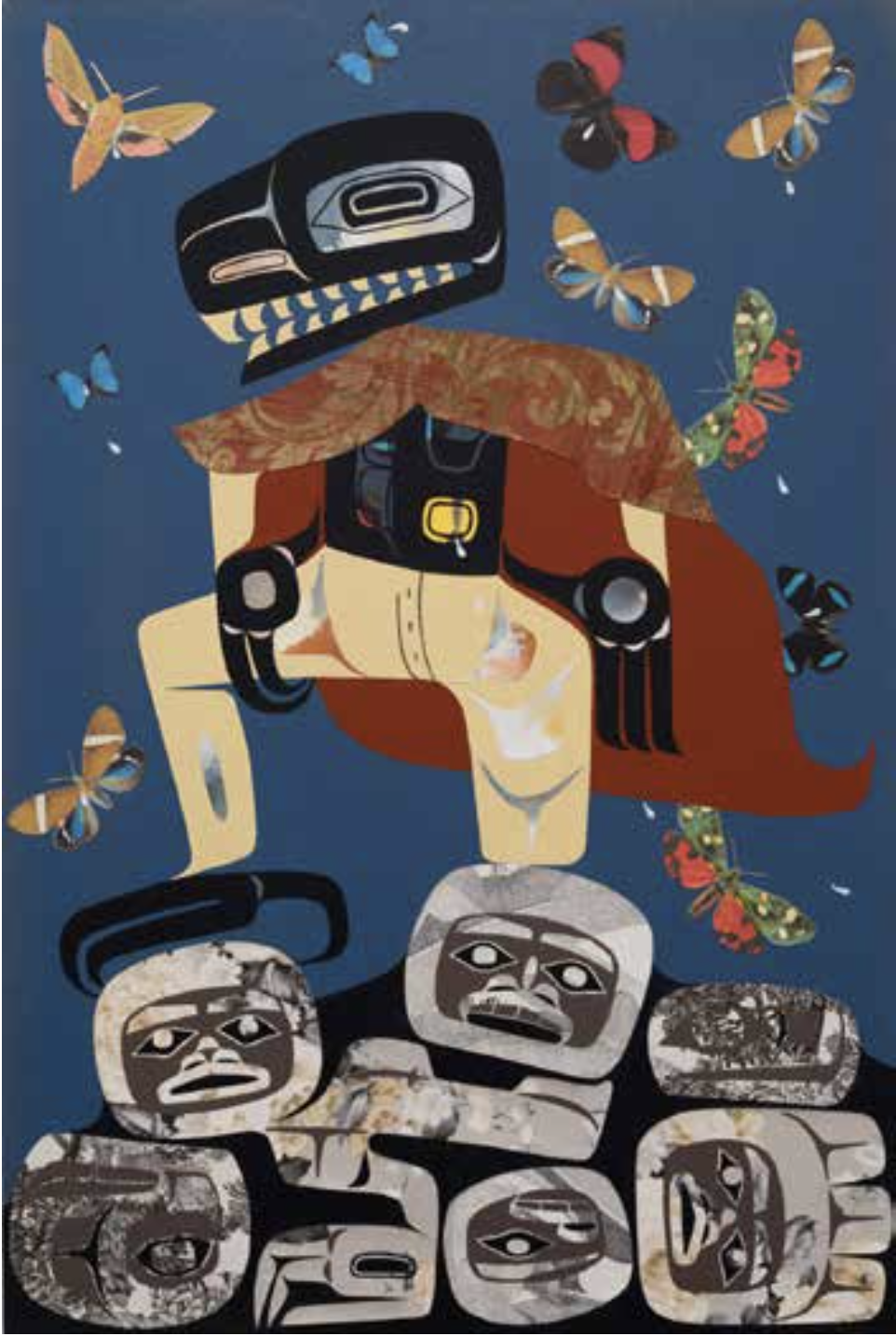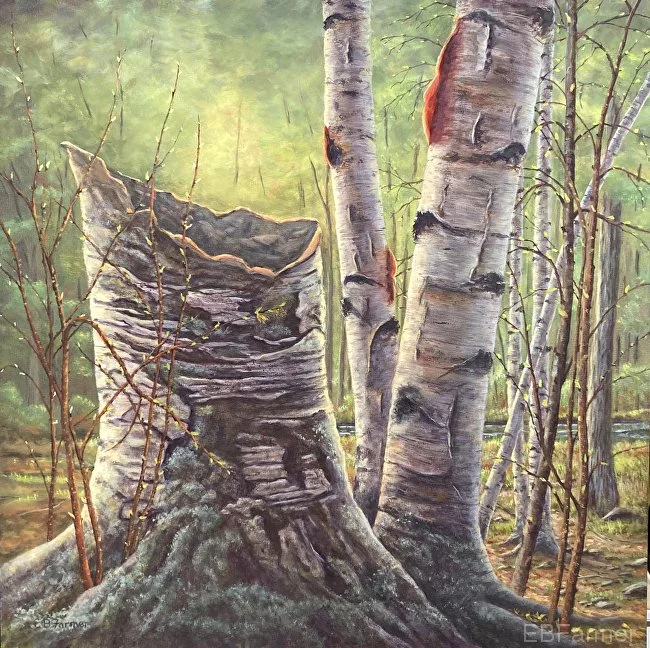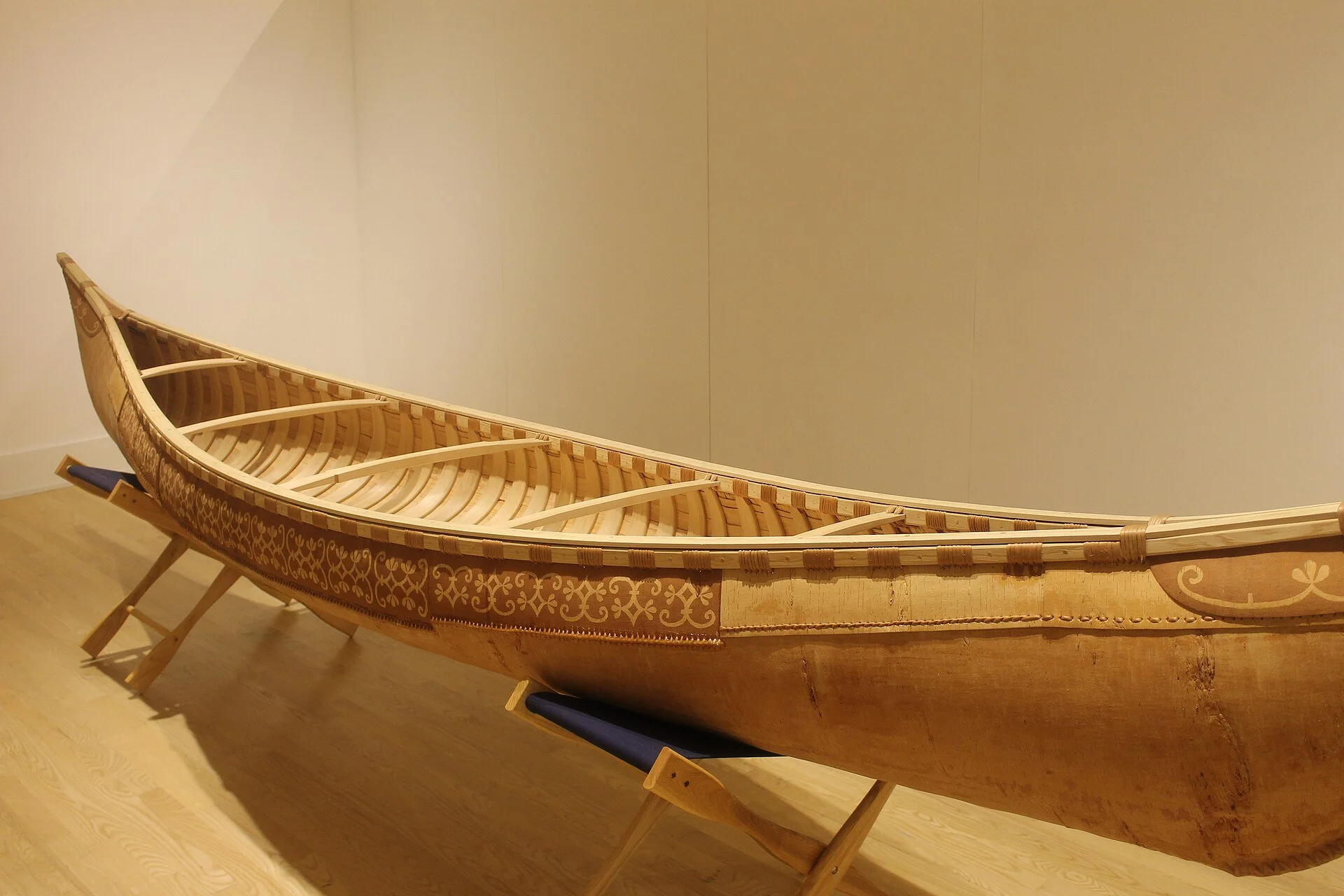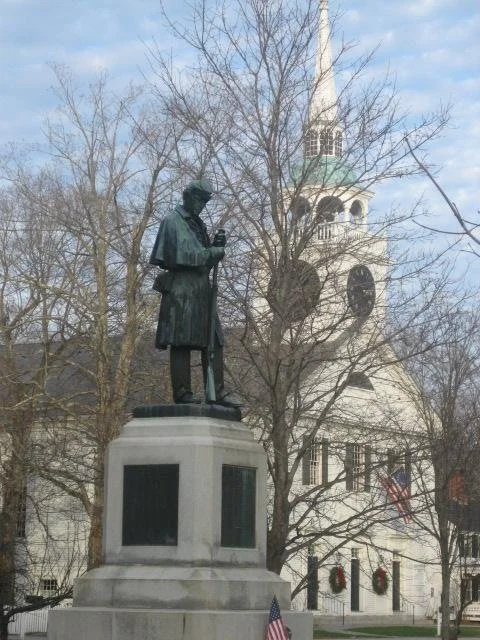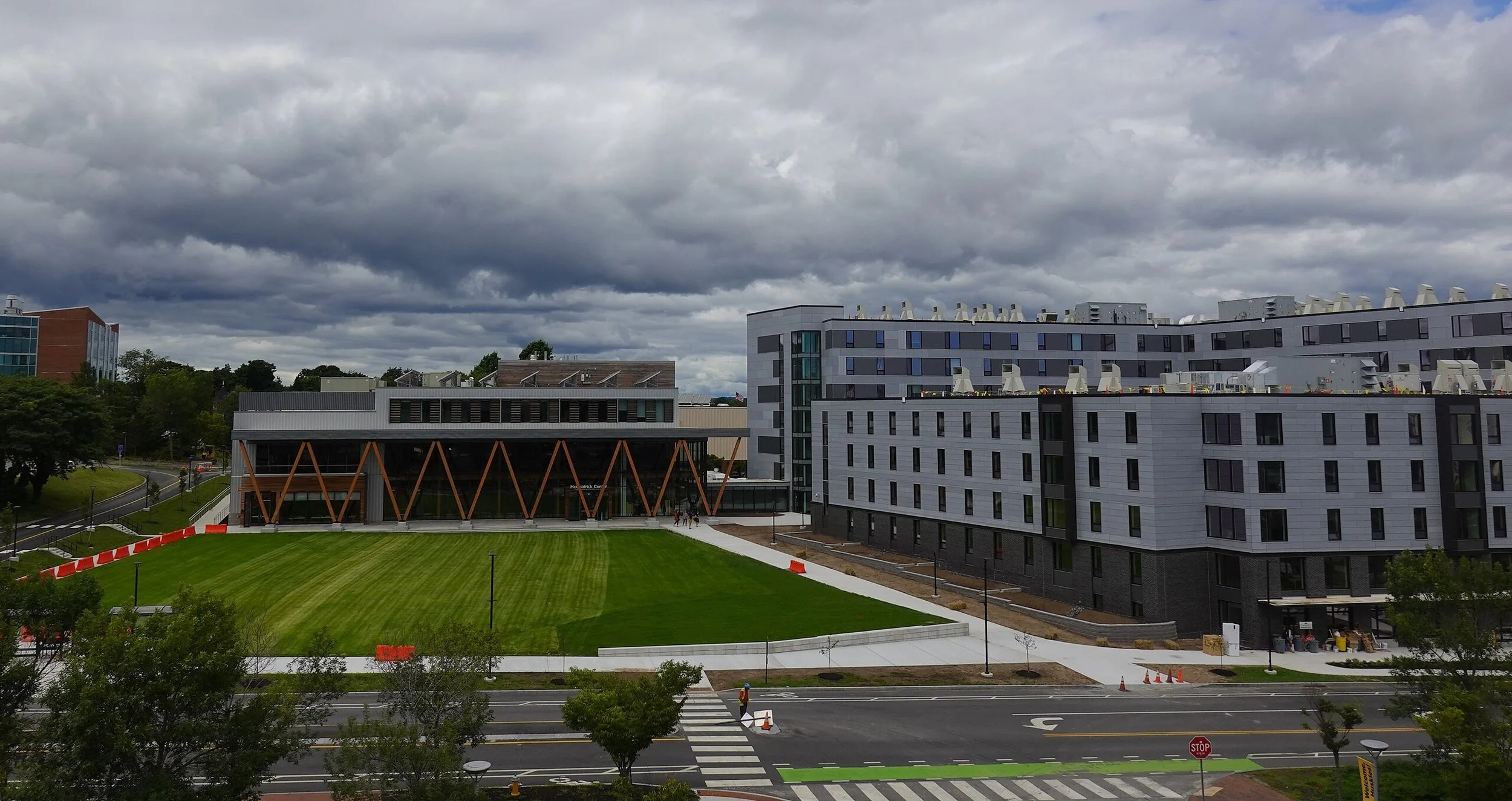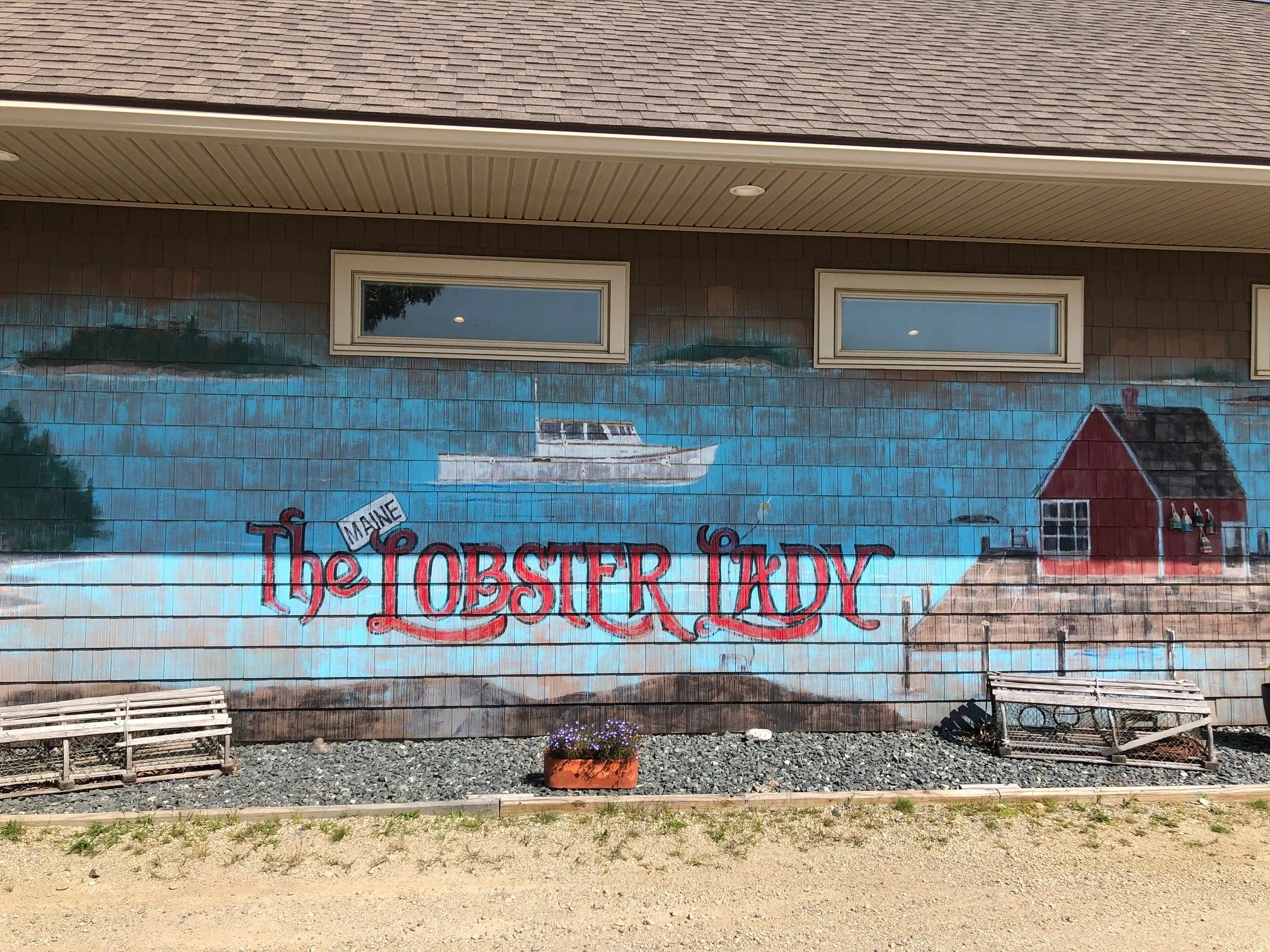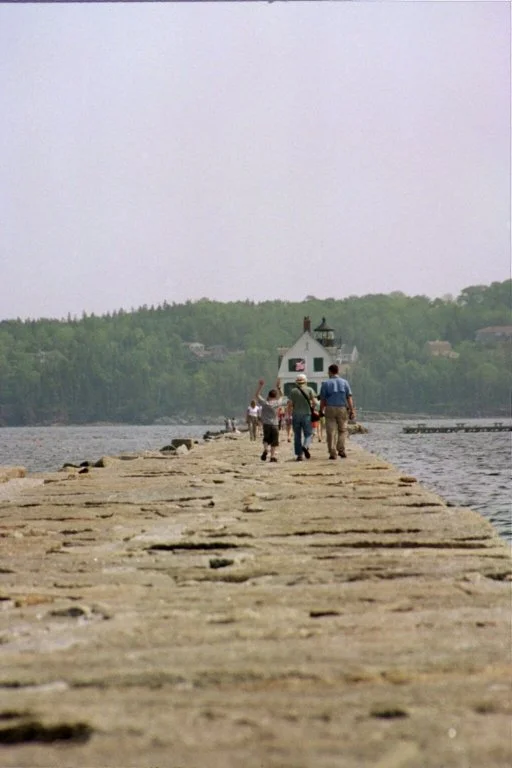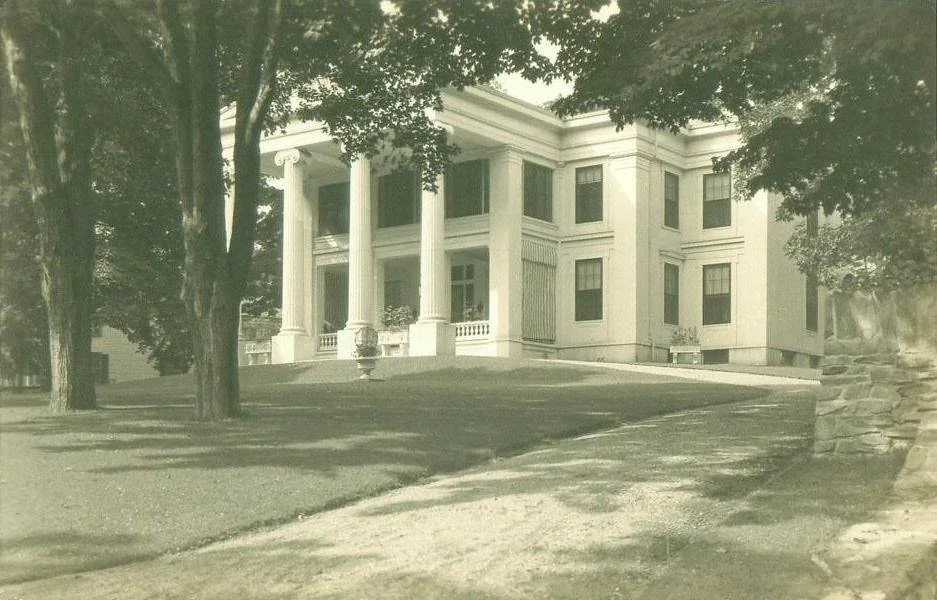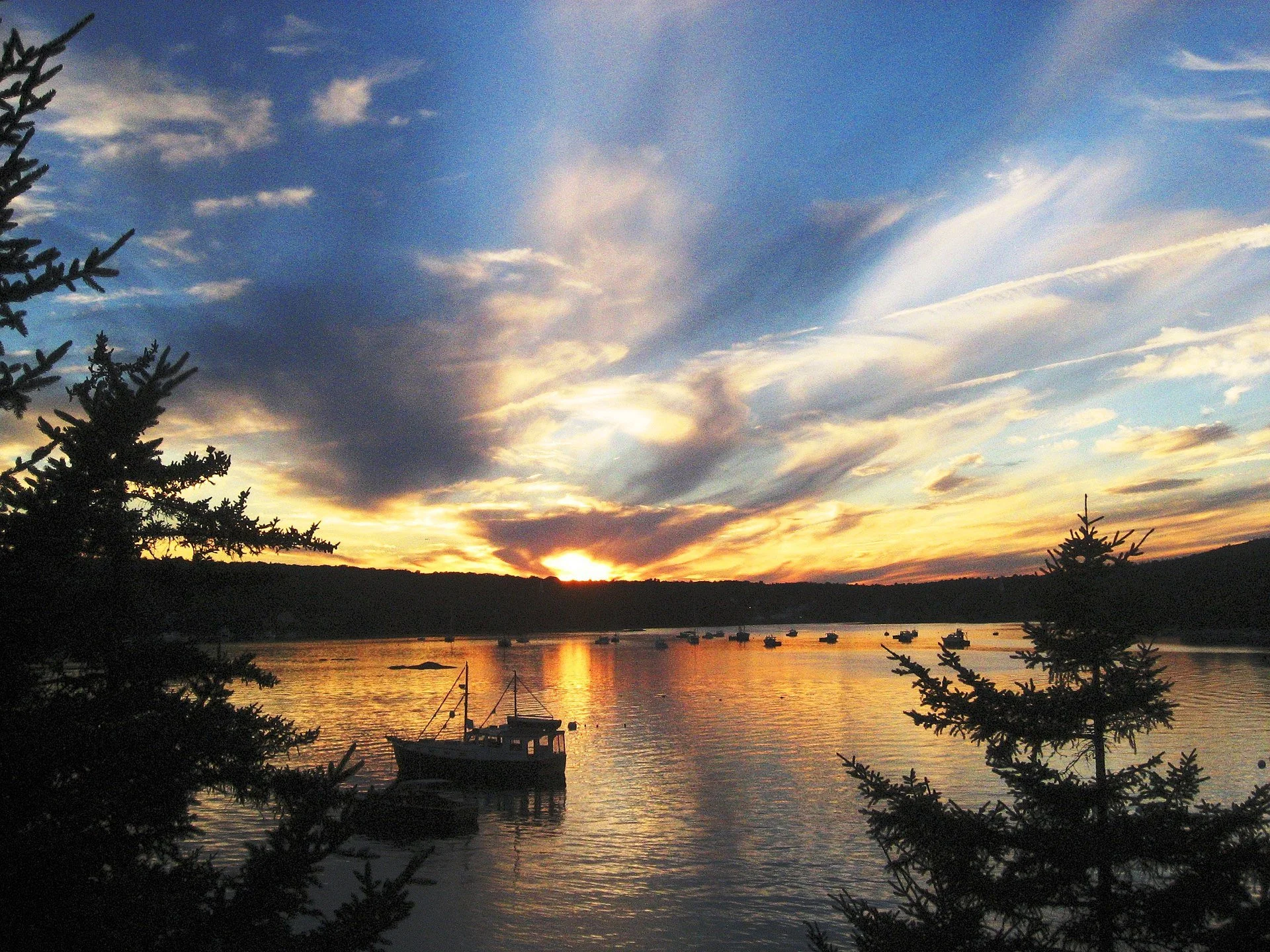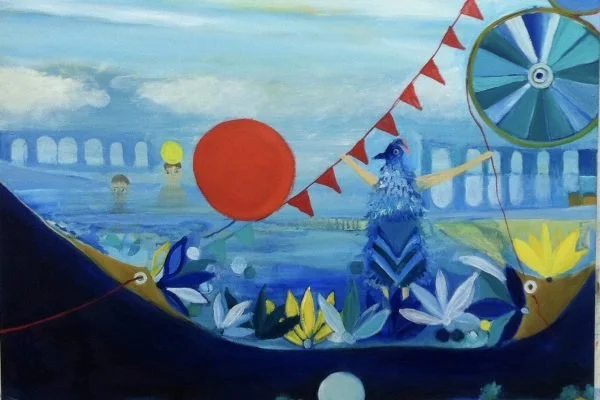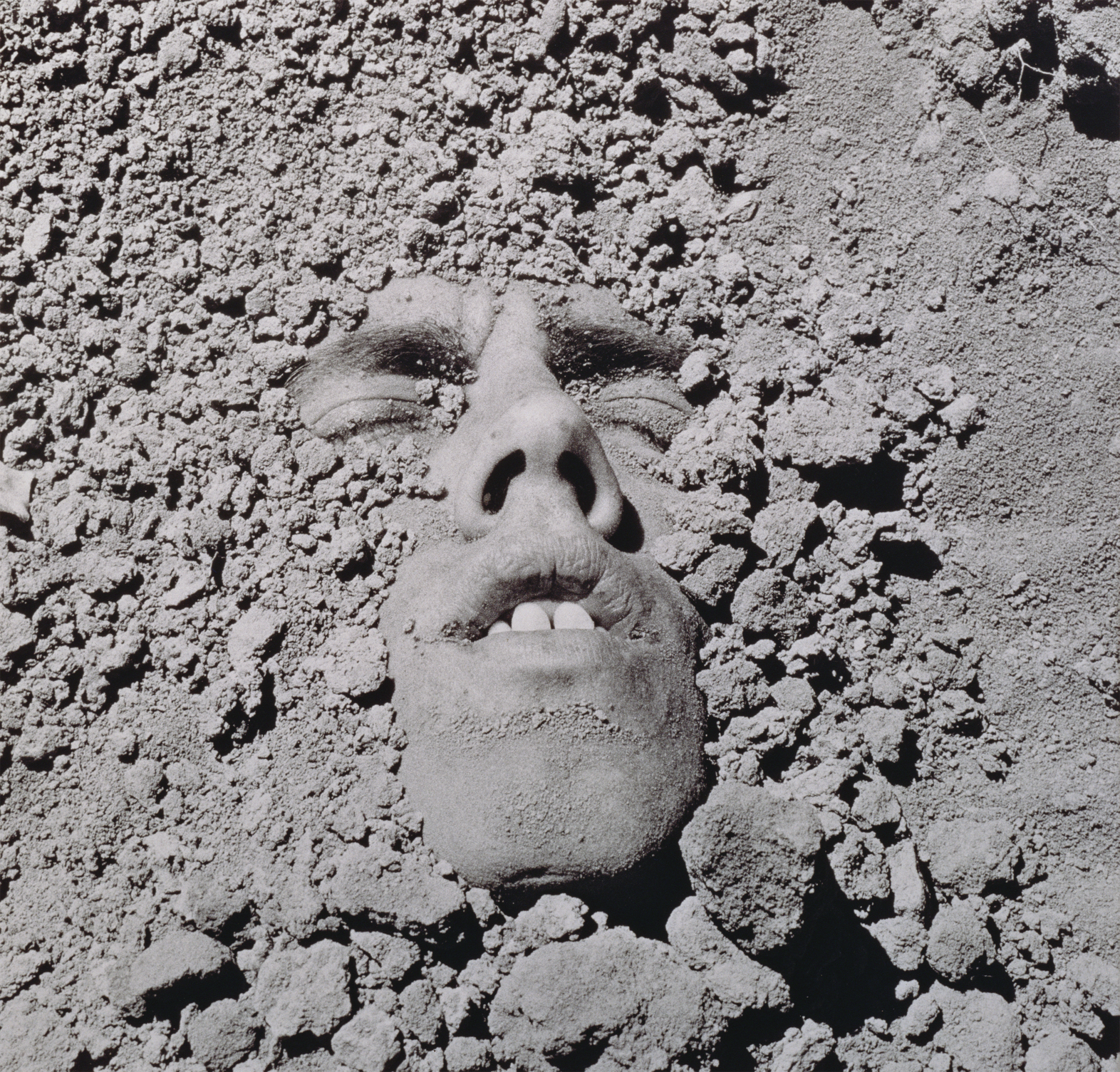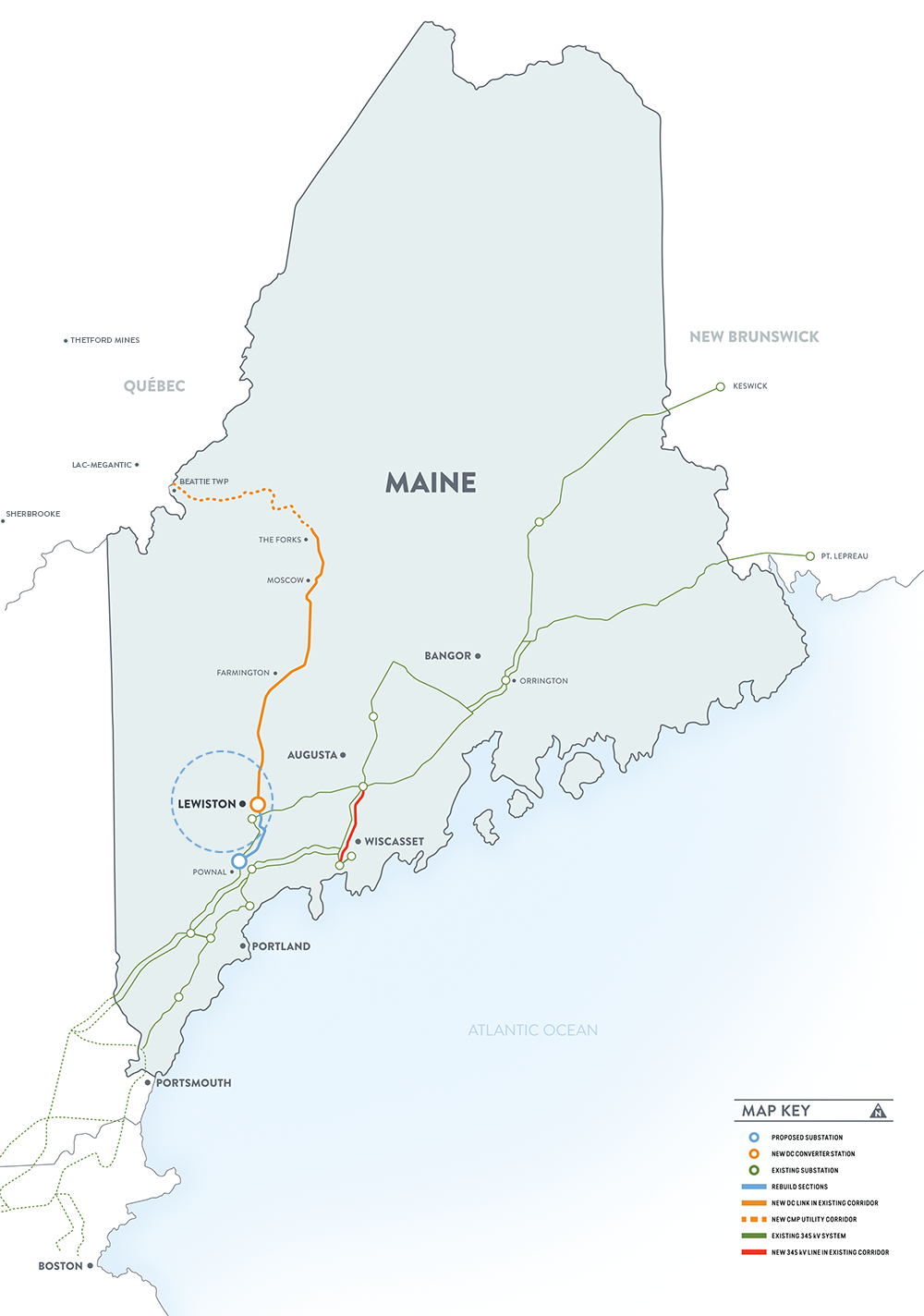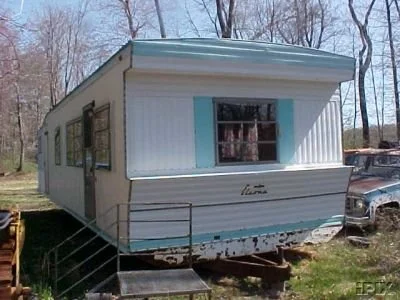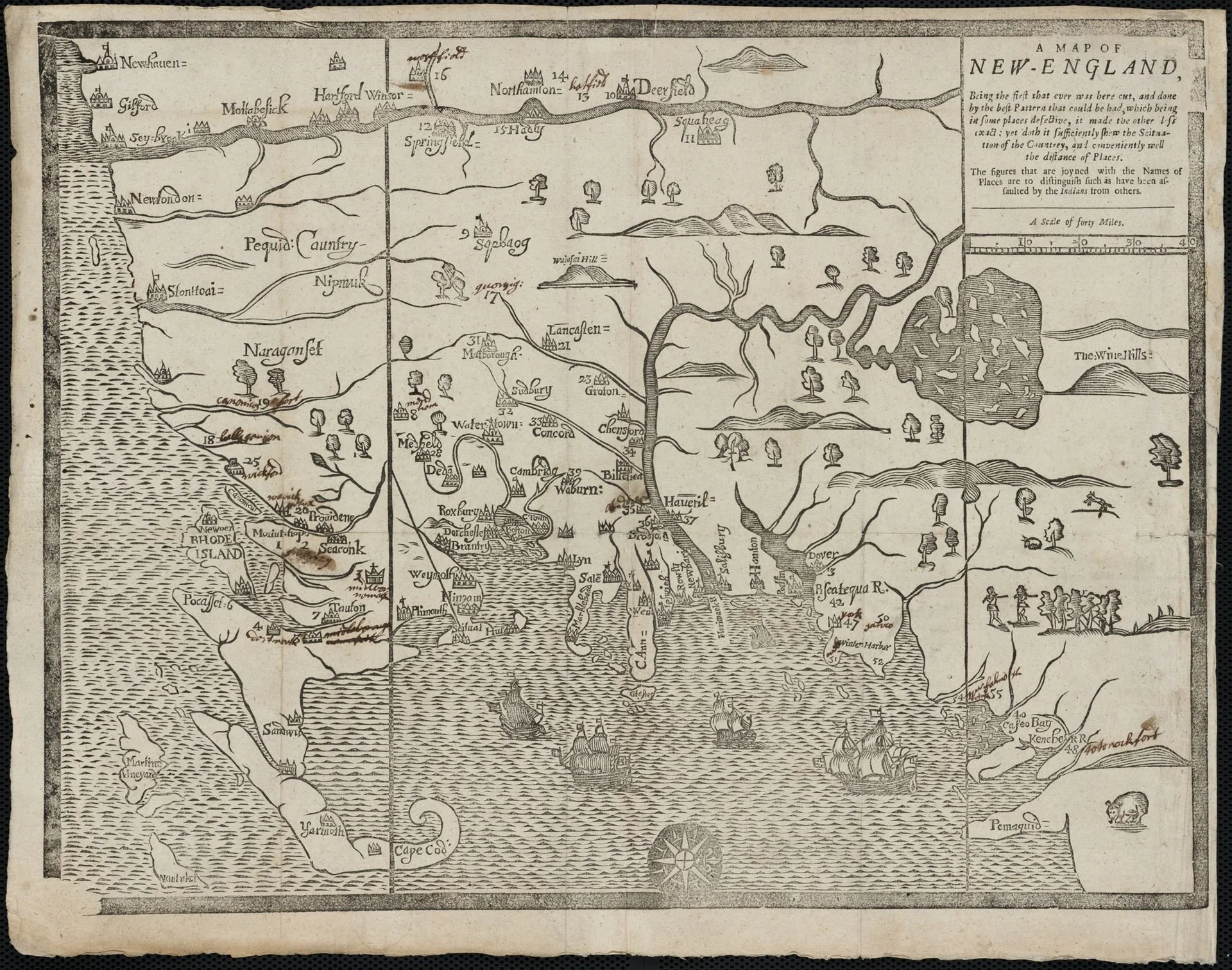
‘Connected life’
From Falmouth, Maine-based artist Allison Hildreth’s show “Darkness Visible,’’ at the Center for Maine Contemporary Art, Rockland, through Jan. 7.
She has said:
“Our earth is a connected fabric of life, interdependent, a product of a long evolutionary process. Bats, the animals that weave the night sky in a chaotic flight, are, for me, the epitome of the wildness of nature.’’
Casco Bay from Falmouth, Maine in 1905.
Rendering of Fort Casco, in Falmouth, in 1705.
Can’t keep
Canada geese
“Some woman every year
Must catch her breath and weep
With so much wildness near
At all she cannot keep.’’
— From “The Geese,’’ by May Sarton (1912-1995), prolific Belgian-American writer. In the last 22 years of her life, she lived in a house (since demolished) on the coast of York, Maine.
To read/listen to the whole poem, hit this link.
The Wiggly Bridge, in York, is the smallest pedestrian suspension bridge in the United States.
—Photo by Bigmacthealmanac
But it usually doesn't usually last long
“Infatuation” (acrylic, wallpaper on canvas), by Allison Bremner, at Bates College (Lewiston, Maine)) Museum of Art.
— Image courtesy of artist, who is of Alaskan Native American background.
Hathorn Hall, at Bates College
— Photo by Odwallah
Textile mills in Lewiston along the Androscoggin River about 1910. The city became a major industrial center in the mid-19th Century, first with sawmills, then with textiles. Money from the latter helped found Bates College, in 1864. Many of the workers were of French-Canadian background, and French used to be widely spoken in the city.
Sadly, Maine’s second largest city, after Portland, became nationally know for Robert Card’s mass shooting there on Oct. 25. that killed 18 people in the normally peaceful place.
Make sure the ax is well-cooked
—Photo by Rhododendrites
“Everybody remembers the recipe for cooking a coot: put an ax in the pan with the coot, and when you can stick a fork in the ax, the coot is done.’’
— John Gould (1908-2003), Maine-based (mostly humorous) writer, in “They Come High,’’ in New England: The Four Seasons (1980)
Coot are coastal birds that hunters in New England shoot at in the fall, despite their tough, oily flesh.
Enough to start working on a canoe?
Painting by Elaine Farmer, the Amherst, N.H., based painter who owns White Birch Fine Art.
Birchbark canoe at Abbe Museum, in Bar Harbor, Maine
— Photo by Billy Hathorn
At the Amherst, N.H., common, with the sort of Civil War statute you see in so many New England towns.
At the University of Southern Maine, ethics training in artificial intelligence
The McGoldrick Center for Career & Student Services, left, the Bean Green, and the Portland Commons dorm at the University of Southern Maine’s Portland campus.
— Photo by Metrodogmedia
AI at work: Representing images on multiple layers of abstraction in deep learning.
— Photo by Sven Behnke
Edited from a New England Council report:
“The University of Southern Maine (USM) “has received a $400,000 grant from the National Science Foundation to develop a training program for ethical-research practices in the age of artificial intelligence.
“With the growing prevalence of AI, especially such chatbots as Chat-GPT, experts have warned of the potential risks posed to integrity in research and technology development. Because research is an inherently stressful endeavor, often with time constraints and certain desired results, it can be tempting for researchers to cut corners, leaning on artificial intelligence to imitate the work of humans.
“At USM’s Regulatory Training and Ethics Center, faculty are studying what conditions lead to potential ethical misconduct and creating training sessions to make researchers conscious of their decisions and thoughts during their work and remain aware of stressors that might lead to mistakes in judgment. Faculty at USM believe this method will allow subjects to proactively avoid turning to unethical AI assistance.
“‘We hope to create a level of self-awareness so that when people are on the brink of taking a shortcut they will have the ability to reflect on that,’ said Bruce Thompson, a professor of psychology and principal at the USM ethics center. ‘It’s a preemptive way to interrupt the tendency to cheat or plagiarize.’’’
Downeast joys
Above, Treasures and Trash Barn in Sedgwick, Maine
Below, now closed lobster shack on Isle au Haut, an eatery once famous for its prize-winning lobster rolls.
— (The new!) photos by William Morgan
1908-1909 photos
Tom Conway: OT rules put lives at risk and strain families
The paper mill town of Madawaska, Maine
—Photo by P199
Via OtherWords.org
She only wanted a few hours at her dying mother’s bedside. But her bosses at Twin Rivers Paper, in Madawaska, Maine, forced her to work overtime on her day off. About an hour and a half into the mandatory shift, the woman’s mother died.
Workers are battling harder than ever to end this appalling mistreatment. They’re fighting back against mandatory overtime requirements that strain families to the breaking point and put lives at risk.
“It’s definitely caused a lot of heartache,” said David Hebert, financial officer and former president of United Steelworkers (USW) Local 291, one of three USW locals collectively representing about 360 workers at Twin Rivers.
USW members have long warned paper companies about the need to increase hiring and training to keep facilities operating safely. Yet some employers prefer to work people to the bone. Workers at Twin Rivers work a base shift of 12 hours — and each can be drafted for an additional 12-hour shift every month.
Even worse, a 12-hour shift can be extended with six hours of mandatory overtime without warning. Workers are often forced to pull multiple 18-hour days a week, especially when winter cold and flu season exacerbates the company’s intentional understaffing.
“People really hold their breath at the end of their shift,” explained Hebert. The coworker who lost her mother, for example, learned at the end of an 18-hour shift that she’d have to report the following day for overtime.
Other workers experience their own heartaches when unpredictable schedules leave them unable to make plans with their families or force them to miss graduations, anniversaries, birthday parties, or holiday gatherings.
“Family is the only reason we go into these places. I want to spend time with them, too,” said Justin Shaw, president of USW Local 9, which represents workers at Sappi’s Somerset Mill, in Skowhegan, Maine.
“You’ve got many people who work seven days a week,” with some required to log 24 hours at a stretch, Shaw said. “If we had better staffing levels, we wouldn’t have people working outrageous hours.”
Besides the toll it takes on family life, excessive overtime compounds risk in an industry that exposes workers to hazardous chemicals, fast-moving machinery, super-hot liquids and huge rolls of paper.
“It only takes a split second to lose a finger, an arm, or a life,” Shaw said, warning that extreme fatigue also puts workers at risk while commuting. “I’ve had many drives home that I can’t recall over half the ride. We have had many individuals in the ditch or wreck vehicles trying to keep up with the demands.”
A bill in Maine would limit mandatory overtime to no more than two hours a day and require employers to provide a week’s notice before mandating extra hours or changing a worker’s schedule.
The legislation places no caps on voluntary overtime, nor would it apply to true emergencies when a mill needs extra hands to avert “immediate danger to life or property.” But it would end the capricious usurping of workers’ lives that now occurs because the industry refuses to hire enough people.
Union members also continue to drive change at the bargaining table. Some workers are pushing to create “share pools” of workers whose role is to fill in where needed on a given shift.
“Share pools” virtually eliminated mandatory overtime at the Huhtamaki facility in Waterville, Maine, where workers once had to put in so many hours that some slept in their cars rather than commute home, said Lee Drouin, president of USW Local 449.
Drouin said other paper companies also need to realize that change is essential for workers but benefits them as well. “The mills have to understand, this is not going to go away,” he said. “To me, it makes a lot more sense to have happy workers and safe workers.”
Tom Conway is the international president of the United Steelworkers Union (USW). This article was produced by the Independent Media Institute and adapted for syndication by OtherWords.org.
The menace of moving
1912 postcard
“In the kind of New England I’m from, you are expected to stay and marry someone from New England – well, Maine, actually – so I think it was seen as a betrayal when I left for New England, which has been my refuge.’’
--Elizabeth Strout (born 1956 in Portland, Maine) is a Pulitzer Prize-winning novelist. She is married to former Maine Atty. Gen. James Tierney and divides her time between New York City and Brunswick, Maine.
‘Sinister phoenixes’
From Chilean-born American artist Rodrigo Valenzuela’s show “Weapons,’’ at the Center for Maine Contemporary Art, Rockland, through Sept. 10.
The gallery says:
“Rodrigo Valenzuela’s exhibition incorporates works from two connected and ongoing photographic series, ‘Weapons’ and “Afterwork,’ that are integrated into floor-to-ceiling wood frame structures installed along with ceramic pieces by the artist.
“Through a patina of nostalgic fantasy, Valenzuela’s ‘Weapons’ series offers views of imaginative performances that might take place on a job site once workers depart. Knives, screws, rope, and chains—the tools of many trades—appear reconfigured as sinister phoenixes, ramshackle sculptures, and animistic creatures of dreams. ‘Afterwork’’ presents pictures of somber, silvery rooms filled with mechanical contraptions and fog, possibly from the sweat left hanging in the air after a long day’s work. Valenzuela’s works are animated by a dream-like quality and driven by an urgent human and political exploration: that of global economics and the human dimensions of labor, considered in the wake of neoliberalism.’’
Heading toward Rockland Breakwater Lighthouse
— Photo by Needsmoreritalin
‘Dread revelations’
“Maine Woods” (oil paint), by Marsden Hartley (1877-1943)
Mount Katahdin in October
“Oh that we might be left alone for hours, to watch the changes of the landscape and hear the secret voice and dread revelations of these magnificent mountains! There are thoughts, deep and holy, which float through one’s mind, as, gazing down upon such a scene, one contrasts the smallness of man with the magnitude of God’s works, and in the weird silence contemplates the perishable of this world with the everlasting hills.
— From Canoe and Camera: A Two Hundred Mile Tour Through the Maine Forests, by Thomas Sedgwick Steele (1845-1903), American painter, photographer, writer and outdoorsman
From a bay’s sea, sky, sand and rocks
“Rock 234: Yellow Flag” (painting), by Tom Gaines (1935-2023), in the show “Tom Gaines: The Last Paintings,’’ at Corey Daniels Gallery, Wells, Maine. Mr. Gaines was based in New Jersey but also painted at his summer home, in Belfast, Maine.
He wrote:
“Since 2005, three major changes have taken place, which have brought me to where I am now… a series of more than 2,000 rock paintings.
“The first change came when I created, quite by accident, a different surface. I had attempted with mineral spirits to wipe out a color that I had allowed to dry for a few days. Some of the color remained, revealing layers of old and new color. This revelation of layers suggested erosion. I was so taken with the result that I purposely worked this way with subsequent paintings.
“The next change came while I was working on a series of interiors and decided to eliminate most of the subject matter. The result was a simpler, more geometric and more abstract composition. I worked this way for more than a year. Simplifying and layering.
“I made a third change while working in my studio in Belfast, Maine. I realized that I needed to prioritize my ideas regarding the relationship between subject matter and form. I found the simpler subject matter/composition from the sky, sea, sand, and rocks of Penobscot Bay.’’
#Corey Daniels Gallery #Tom Gaines
Penobscot Bay from Belfast
Blaisdell Residence, Belfast, from a circa 1920 postcard. It’s a Greek Revival mansion from the city's 19th Century shipbuilding boom. Known as The Williamson House (www.TheWilliamsonHouse.com) survives today as a Museum in The Streets landmark.
Restless gardener
Phlox
“Today I’d like nothing more strenuous than to sit still and admire the huge heads of phlox that the wet season has produced in the perennial borders and watch the bees sipping nectar from the poisonous monkshood and plundering the lavender spikes of the veronicas. But a gardener’s mind is restless; it runs on ahead, and that is the penalty that one pays for the life of culture.’’
— Katherine S. White (1892-1977), famed New Yorker magazine editor, in her only book, Onward and Upward in the Garden. She was married to the writer E.B. White and lived in most of the latter years of her life in Brooklin, Maine, on the Blue Hill Peninsula, where she had her garden.
Maine lushness
"Boothbay Harbor Botanical Gardens" (oil on panel), by Louis Guarnaccia, at Bayview Gallery, Brunswick, Maine.
Not so much now
Southern Maine beach house in 1914
“The first ‘hot’ day of the season has happened. I put ‘hot’ in quotation marks because in Maine the term is strictly relative. Most people can live in Maine for years without learning what hot really means; some of them may never learn unless they leave the state.’’
— John Cole (1923-2003), Maine journalist, author and environmentalist, in his book In Maine (1974)
A carnival’s ‘childlike carefreeness’
“Traveling Circus’’ (oil on canvas), by Alexandra Rozenman, in Brickbottom Artists Association, Somerville, Mass., June 17-29
The gallery says:
‘‘There is a certain special kind of joy that takes place when the carnival comes to town. Nostalgia, excitement, and a childlike carefreeness that can be unshakeable for guests of all ages. The carnival can seem like a very intricate web of logistics but with the proper event planning team, you can put together a five-start carnival just about anywhere. Even your very own backyard.’’
This 1945 Rodgers & Hammerstein Broadway musical is set on the Maine Coast. Rodgers said later it was his favorite of all his shows.
Watch where you step
“Untitled (Face in Dirt)” (pigmented ink print), by David Wojnarowicz (1954-1992) in the show “Come Closer: Selections From the Collection, 1978-1994,’’ at Colby College Museum of Art, Waterville, Maine
The museum explains that “Come Closer” “presents artworks … that explore the relationship between the personal and the political. During this period, artists reflected upon urgent current events and social issues such as gender equality, racial justice, technological advancements, sexual freedom, and the AIDS crisis.”
Hot sand, cold water
“A Day at the Beach,” by Swedish-American painter Carl Sprinchorn (1887-1971), in the show “Shifting Sands; Beaches, Bathers, and Modern Maine Art,’’ at the Ogunquit Museum of American Art, through July 16.,
— Image courtesy of Darin Leese
Foot by foot
New England Clean Energy Connect map
Adapted from Robert Whitcomb’s “Digital Diary,’’ in GoLocal24.com
There’s recently been progress, albeit still too slow, on making New England’s energy greener.
First, there’s that a state jury in Maine has voted 9-0 to let proceed the long-delayed transmission line for moving electricity from Hydro Quebec into our region. In a deeply dubious move, foes of the line, including three companies with natural-gas facilities in the state, had sought to kill the Avangrid Inc. project, called New England Clean Energy Connect. They did this by putting up a ballot question approved by voters after a massive campaign against the project that was aimed at retroactively killing Avangrid’s project, which regulators had approved. Armed with permits, the company had already spent hundreds of millions of dollars before the ballot question to clear the wooded, mostly wilderness route, logically assuming that it could legally do so. Talk about unfair
The jury verdict came in the wake of a Maine Supreme Judicial Court ruling that in effect backed the continuation of the project.
It seems that as of this writing that the project will be completed, adding more clean juice to the region’s grid to such other new green-energy production as also-too-long-delayed offshore wind projects and solar. (Will nuclear fusion to generate electricity eventually be our savior? Research on it, much of it happening in New England, is coming along at a good clip.)
Utility Dive reported:
Anne George, spokesperson for ISO New England (which manages the region’s grid), said that it’s pleased that the project can move forward.
“The New England states’ ambitious climate goals will require building significant amounts of new infrastructure in a region where building infrastructure has been difficult,’’ she said.
Phelps Turner, a senior lawyer at the Conservation Law Foundation, said the delay caused by the legal challenge is “symptomatic of building energy infrastructure in New England.”
“We lost a lot of time.’’
New England, despite many of its citizens’ progressive rhetoric, is a remarkably Nimby place, in energy matters, housing and some other fields. Many Red States have done far more than New England in setting up renewable-energy operations.
Then there are such little noted options as geothermal. Consider National Grid’s pilot program at the University of Massachusetts at Lowell. The company will use boreholes to see if a geothermal network can be established there using piping and pumps to pull heat out of the ground to warm the university’s buildings in cold weather and then pump heat from them into the ground to cool them in the summer.
#New England Clean Energy Connect
Maine country place
“When Daddy’s downcellah busy with his lathe, I go to the edge of the grass to get a look at the Beans. The Beans’ mobile home is one of them old ones, looks like a turquoise-blue submarine. It’s got blackberry bushes growin’ over the windows.’’
— From The Beans of Egypt, Maine (1985), by Carolyn Chute (born 1947)

